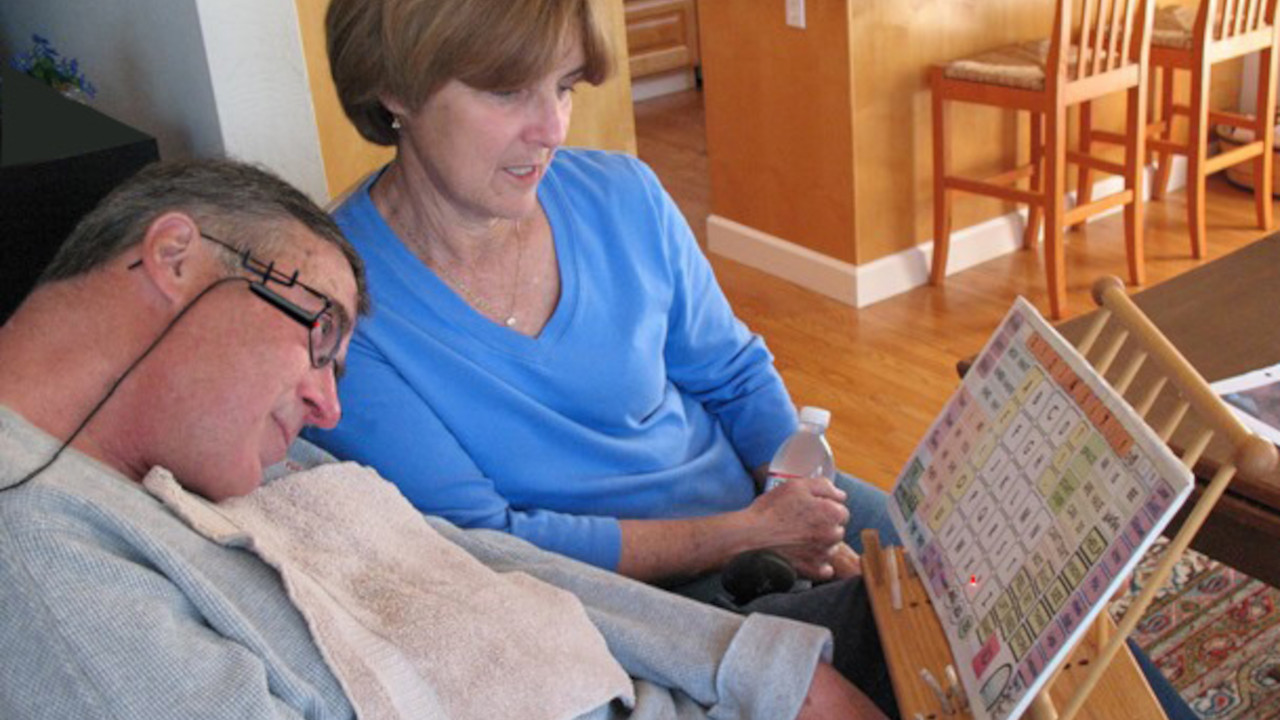ALS and other motor neuron diseases
 A person with ALS wears a spectacle frame with a laser pointer. The laser pointer is pointed at a board with letters - a communication board. Photo by Fezcat on Wikipedia under CC BY-SA 4.0
A person with ALS wears a spectacle frame with a laser pointer. The laser pointer is pointed at a board with letters - a communication board. Photo by Fezcat on Wikipedia under CC BY-SA 4.0
This chapter describes what motor neuron diseases are, the challenges faced by those affected and the extent to which eye-tracking systems can help.
Motor Neuron Diseases: Progressive Loss of Body Control
Motor neuron diseases (MND) are neurological disorders that affect the nerve cells responsible for controlling muscle movement. They lead to a progressive degeneration of the so-called motor neurons, which can result in muscle weakness, paralysis and ultimately the loss of basic physical functions such as speaking, swallowing and breathing. One of the best known diseases is amyotrophic lateral sclerosis (ALS). The exact cause of MND is often unknown, but genetic or environmental factors may play a role.
Sufferers can hardly communicate any more: Social isolation and problems with care are the result
One of the consequences of motor neuron disease is impaired communication. Those affected often lose the ability to speak or write due to muscle paralysis. In the later stages, often only conscious eye movement remains.
Those affected and their relatives must now become creative. Communication is possible, for example, via simple "yes-no" questions with blinking or with communication boards. However, this requires time and patience from everyone involved. Nursing staff, who are already under a lot of pressure, are often unable to devote this time. Under time pressure, communication must be reduced to the bare essentials. It is impossible to clarify complex issues. Just asking for a scratch on the left wing of the nose? Unimaginable.
This creates a vicious circle in the hospital room: without a way to communicate needs, pain or fears, those affected can easily be overlooked or misunderstood. This reinforces the feeling of helplessness and dependency. The loss of speech is far more than a physical problem - for many, it means a loss of identity and self-determination.
Care for people with MND must therefore go far beyond medical treatment. Technological and, above all, social support is needed to maintain their communication for as long as possible and ensure their participation in social life. This is the only way to enable a dignified life despite the disease.
Eye- and Head-Tracking as an Aid to Communication
Eye and head tracking are technologies that record movements of the eyes or head in order to control devices such as computers or communication aids. These systems are particularly important for people affected by motor neuron disease. They make it possible to remain interactive and express themselves despite paralysis. In MND sufferers in particular, eye movement is often retained until late in the disease. For example, this technology makes it possible to write text, output computer-generated speech or even operate the entire computer simply by looking at it.
These technologies not only enable communication with relatives or caregivers, but also participation in digital and social activities. This reduces isolation and increases quality of life. Modern eye- and head-tracking systems are now precise, user-friendly and can be customized. They open up new ways for people with severe physical limitations to communicate and actively participate in life.
